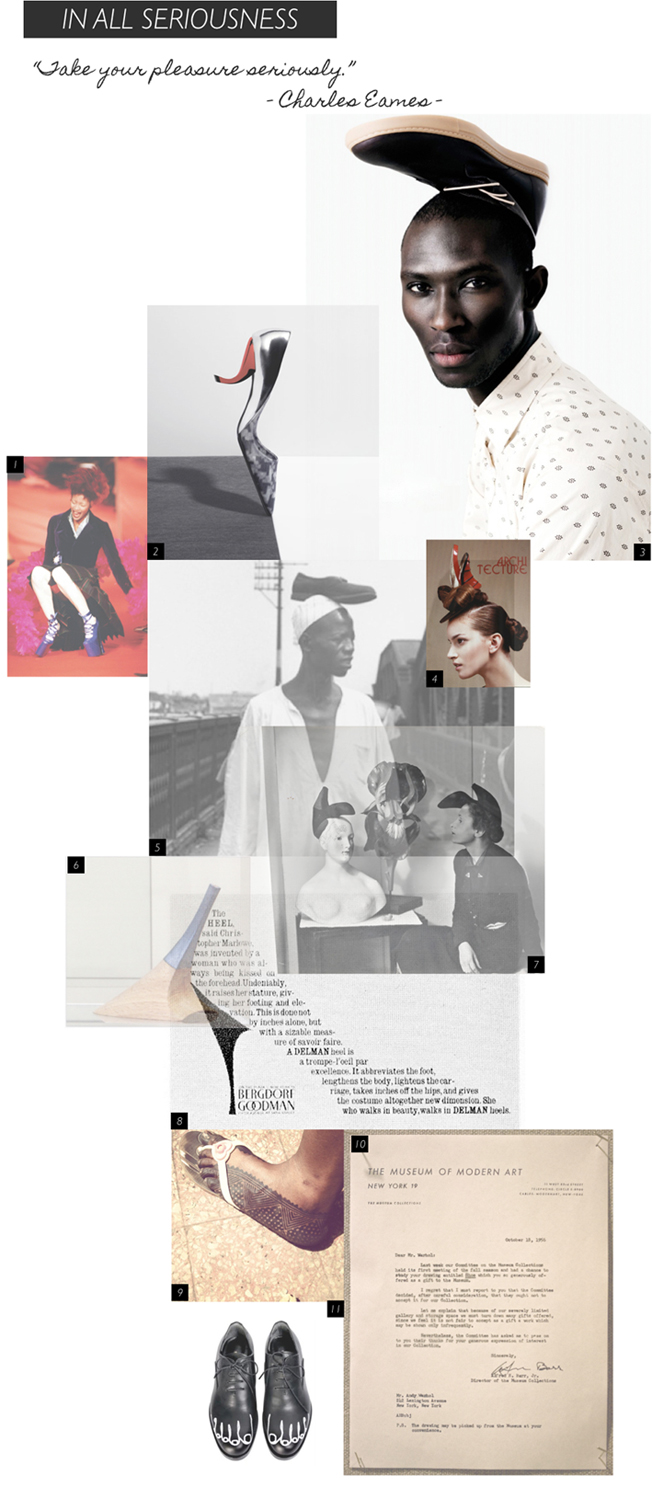Take your pleasure seriously.
Charles Eames
HOW WE UNDERSTAND FASHION is a collection of infinite possibilities, projected images and representations. At once enigmatic, desirable, glamorous, festive, authoritarian; dress is a multi-dimensional concept that might be described and observed a countless number of ways, from anthropological costume to the revered fashion image. More importantly perhaps, fashion occurs in many locations, and simultaneously across the globe. In effect, it does not follow the hierarchical template it aspires to, it instead should be read as a collective, global experience. Our understanding of dress is part of a galaxy of references across time and place: in 1937 Elsa Schiapparelli releases her ‘Shoe Hat’, an exercise in sartorial surrealism, while 4,500 kilometres away, a Nigerian man is photographed by Alfred Eisenstaedt walking the street with a shoe atop his head, for reasons unknown. Both images are connected by fashion and but each is inscribed with a myriad of cultural, aesthetic, social characteristics that continue our complex and rich experience of clothing.
In a collaborative series, ‘Sartorial Meditations’, Another Africa‘s Missla Libsekal shares with Vestoj some of her notes on fashion; curating the aesthetic correlations that exist in dress and the fashion image, and reflecting on fashion’s transformative power across the globe. We begin the series with some notes on form, silhouette and its potential for absurdity in this first instalment: ‘In All Seriousness’.
Take the archetypal format of the shoe, both a sartorial adornment and an independent object in space. In shifting the placement from the foot to the head, Schiapparelli’s ‘Shoe Hat’ sought to break the conventions of form and function, this piece has been celebrated as a canonical ‘moment’ in fashion discourse. With similar surreal playfulness, a pair of shoes from the Comme des Garçons autumn/winter 2009 collection, pokes fun at the act of covering the body, by illustrating the hypothetical toes within.
Fashion’s emphasis on ‘balance’ as a design directive and aesthetic value also comes into play here, for the 2013 retrospective of the shoe designer Roger Vivier at the Palais de Tokyo in Paris, the cover image of the balancing shoe was chosen. The graphic photograph (originally used in an advertising campaign for the brand) reminds us of the physicality of balance as a design principle within the functions of the object. After all, a good heel is an exercise in balance in itself. In keeping with this, Vivier explains his design process, ‘I’ll resketch my drawing five hundred times to check the exactness of the idea and respect the foot’s architecture.’
In contrast, the absurdity and exaggeration of the function of dress is also an aesthetic tool, perpetuating the oft-conceived notion that fashion is a frivolous exercise. A strong image of this is Naomi Campbell’s infamous tumble in walking the catwalk for the Vivienne Westwood spring/summer 1998 collection. The image has since become symbolic of hyperbolic fashion. This is a very physical notion of balance, and under similar principles, the Nigerian man rests his shoe atop his head, reminding us that fashion is, above all, a piece of clothing that can be placed around the body and throughout different contexts.
Fashion’s ability to transform itself and consistently evolve, derives from the notion of breaking codes. When looking at the changing silhouette of the fashioned body through the past, each moment of innovation is the product of defiance from convention, of pushing boundaries. Playing with these ideas forces us to reassess our collective cultural values time again. Warhol’s letter from the Museum of Modern Art in New York brings the notion of absurdity and breaking of convention sharply into focus. His proposal of a shoe as an art piece for the gallery is ridiculous and insightful, as Warhol seems to parody both the fashion and art world in his sartorial offering to the institution.
At times ridiculous, profound, dynamic, these connections and constellations that emerge in examining the form of clothing as ornament of the body, and the fashioned image, encourage a more playful and democratic interpretation of dress, echoing the simple words of Charles Eames, ‘Take your pleasure seriously’.
- Naomi Campbell takes a tumble during the Vivienne Westwood autumn/winter 1993 catwalk presentation at Paris Fashion week
- Cover image for the Roger Vivier retrospective exhibition, ‘Virgule, etc… Dans les pas de Roger Vivier’ at the Palais de Tokyo, Paris in 2013
- Armando Cabral photographed by Richard Pier Petit, with styling by Carl Barnett
- Hair by Olivier Schawalder for Vogue Pelle
- ‘Nigerian Man Carrying a Shoe on His Head’ by Alfred Eisenstaedt, April 1953
- An early example of a stiletto heel, from the International Footwear Museum of Vigevano, Italy c.1952
- Elsa Schiaparelli, shoe hat 1937/1938 collection.
- Delman Shoes at Bergdorf Goodman advertisement, designed by Reba Sochis of Sochis Advertising & Promotion, c.1960s
- ‘Henna vs. Bamako, Mali’ by Glenna Gordon, 2013
- The rejection letter to Andy Warhol from MoMA in 1956 of his gifted artwork entitled ‘Shoe’, the letter reads:Dear Mr. Warhol:Last week our Committee on the Museum Collections held its first meeting of the fall season and had a chance to study your drawing entitled ‘Shoe’ which you so generously offered as a gift to the Museum.I regret that I must report to you that the Committee decided, after careful consideration, that they ought not to accept it for our Collection.Let me explain that because of our severely limited gallery and storage space we must turn down many gifts offered, since we feel it is not fair to accept as a gift a work which may be shown only infrequently. Nevertheless, the Committee has asked me to pass on to you their thanks for your generous expression of interest in our Collection.Sincerely,Alfred H. Barr, JrDirector of the Museum Collections P.S. The drawing may be picked up from the Museum at your convenience.
- Shoes from Comme des Garçons autumn/winter 2009 collection
Missla Libsekal is the founding editor of Another Africa.
